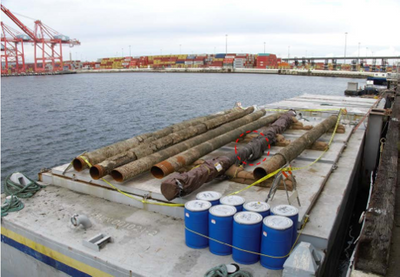NTSB Recommends Pipeline Operators Implement Safety Management Systems
The U.S. National Transportation Safety Board (NTSB) is recommending new notification alarms and procedures for potential incursions on pipelines and a change to an anchorage off the California coast following a crude oil release in 2021 caused by ship anchors damaging an underwater pipeline.
NTSB investigators determined that the oil leak, which began on October 1, 2021, in San Pedro Bay, resulted from an anchor strike on the pipeline that occurred eight months earlier, when anchors from the containerships Beijing and MSC Danit dragged and contacted the pipeline during high winds and seas caused by a cold front. The proximity of the anchorage positions the vessels were assigned to did not give the crews sufficient time or space to heave in their dragging anchors before contacting the pipeline. The NTSB determined the MSC Danit anchor’s contact with the pipeline was the initiating event that led to the crude oil release.
An estimated 588 barrels of oil leaked from the pipeline, resulting in approximately $160 million in damages, including clean-up costs.
The NTSB recommended the U.S. Coast Guard implement a proposed change to the anchorage where the Beijing and MSC Danit were located when they began dragging their anchors, which would move the boundary of the anchorage farther away from the pipeline. The NTSB also recommended the Coast Guard develop and implement audible and visual alarms for Vessel Traffic Services, or VTS, watchstanders when an anchored vessel is encroaching on a pipeline, and to develop procedures for VTS to notify pipeline and utility operators following potential incursions on submerged pipelines and utilities. VTS provides active monitoring and navigation advice for vessels in confined and busy waterways.
“Anchorages need to be designed to account for the size of vessels using them and the time it takes for these ships’ crews to react when anchor dragging occurs,” NTSB Chair Jennifer Homendy said. “Potential damage to a pipeline needs to be reported immediately because the consequences of a pipeline leak are so great. NTSB investigators identified instances where this leak could have been avoided or mitigated, including making the pipeline operators aware of potential anchor dragging so damage could be identified and repaired before an oil release. Investigators also found that the controllers were not adequately trained to handle abnormal operating conditions, which delayed shutting down and isolating the pipeline.”
Contributing to the leak was the undetected damage to the pipeline, the pipeline operator’s insufficient training of the pipeline controllers, and the pipeline controllers’ inappropriate response to the leak alarms due, in part, to frequent previous communication-loss alarms.
It took eight total leak alarms before controllers shut down and isolated the line. Had the San Pedro Bay Pipeline controllers responded in accordance with company procedures and shut down and isolated the line at the first alarm, it would have significantly reduced the volume of crude oil released and the resulting environmental damage. The NTSB found insufficient training of the pipeline controllers contributed to the 14-hour delay in stopping the pipeline’s shipping pumps, which consequently increased the volume of crude oil released.
The NTSB also issued recommendations to the Pipeline and Hazardous Materials Safety Administration, or PHMSA, the Marine Exchange of Southern California, and owners and operators of pipelines regulated by PHMSA.












